Nearly one-third of Hawaiian flora is on the U.S. Endangered Species List, and more than 230 species have less than 50 individuals remaining in the wild. Since 2016 NTBG and conservation partners statewide have been working to halt the extinction of Polyscias bisattenuata – and it’s working.
On the steep montane face of the island’s windward side, the tradewinds whistle through thick vegetation in an almost melodic manner. There are no roads or structures here, but there is a tiny population of Polyscias bisattenuata – a critically endangered Hawaiian tree nestled in the vegetation and living on the brink of extinction.
“Endemic Hawaiian species have intrinsic value and a rightful place in this landscape.”
“Endemic Hawaiian species have intrinsic value and a rightful place in this landscape,” said Julia Douglas, a Ph.D. student at the University of Hawaii, field botanist, former NTBG intern, and now research collaborator. “A deep in-situ environmental understanding of species is critical to being thoughtful stewards and conducting applicable conservation research,” she continued.
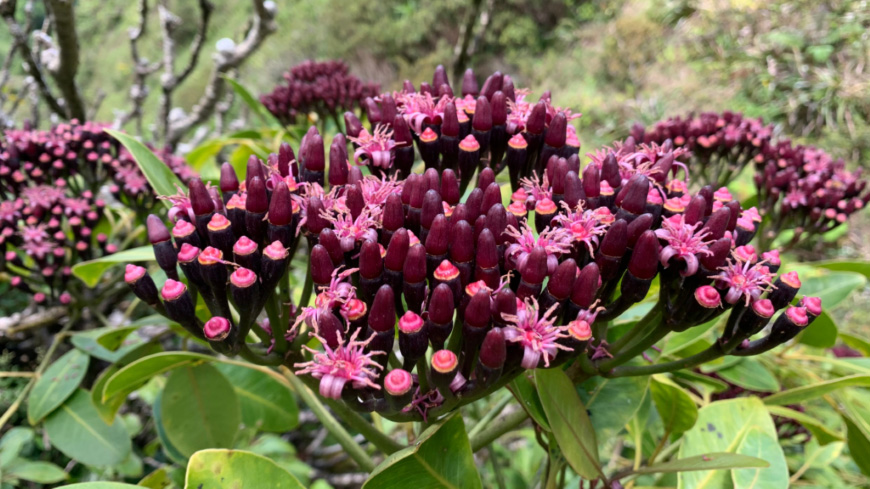
Julia is part of a vast team of scientists, conservationists, volunteers, and supporters from various organizations across the state who have been astute and careful stewards of this incredibly rare species for the last five years. Known to have fewer than 30 individuals remaining in the wild until a 2016 discovery by Natalia Tangalin, former NTBG Living Collections botanist and field collector, Polyscias bisattenuata is a member of the ginseng family (Araliaceae), and also known by the Hawaiian names ohe mauka or ohe ohe. The attractive multi-trunked tree with captivating pink flowers and deep purple fruit is endemic to Kauai’s mesic and wet native forest and documented on the U.S. Federal Endangered Species List, and listed as Critically Endangered on the IUCN Red List.
In the fall of 2016, working with the support of a grant from the Mohamed bin Zayed Species Conservation Fund, Natalia discovered 34 new trees in four previously unknown populations. Her find created a rare opportunity and momentous effort to study, propagate, and establish a stable population of Polyscias bisattenuata in its natural habitat that five years on is making an impact.
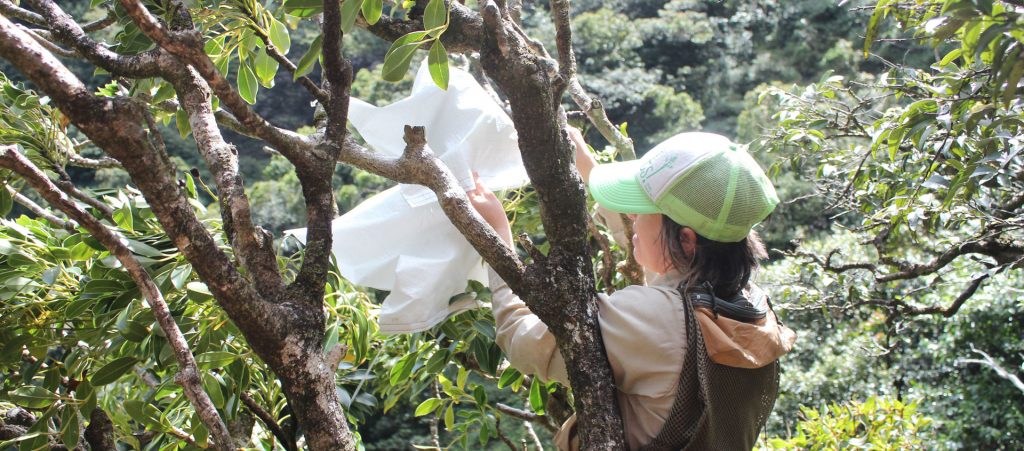
Like many native plants in Hawaii, protecting fruit and seeds from invasive predators is one of the greatest challenges to conservation success. Natalia’s discovery led to an all-hands-on-deck effort by NTBG Living Collections staff, volunteers, and interns to protect the fruit on the trees in hopes of collecting enough seed to study, store, and propagate.
Upon learning of the need to protect Polyscias bisattenuata fruit, NTBG’s Oshibana volunteer craft group offered to design and sew rodent-resistant bags that could be secured over the fruit and branches of the tree to deter rats. After experimenting with many different materials and designs, two volunteers, Maryanne Nordwall and Joanne Watson settled on woven plastic mech sandbags which were easily available on Kauai, flexible, and most importantly unappealing to invasive predators. Together the volunteers sewed more than 100 bags of various sizes with velcro closures that allowed for secure fastening to tree branches and safety for the imperiled fruit. The protective bags worked well and shielded the fruit from rodents until maturity. Over multiple visits, Natalia, NTBG Living Collections field collectors, and KUPU members were able to return and collect more than 55,000 seeds, adding 50 accessions to NTBG’s living collections.
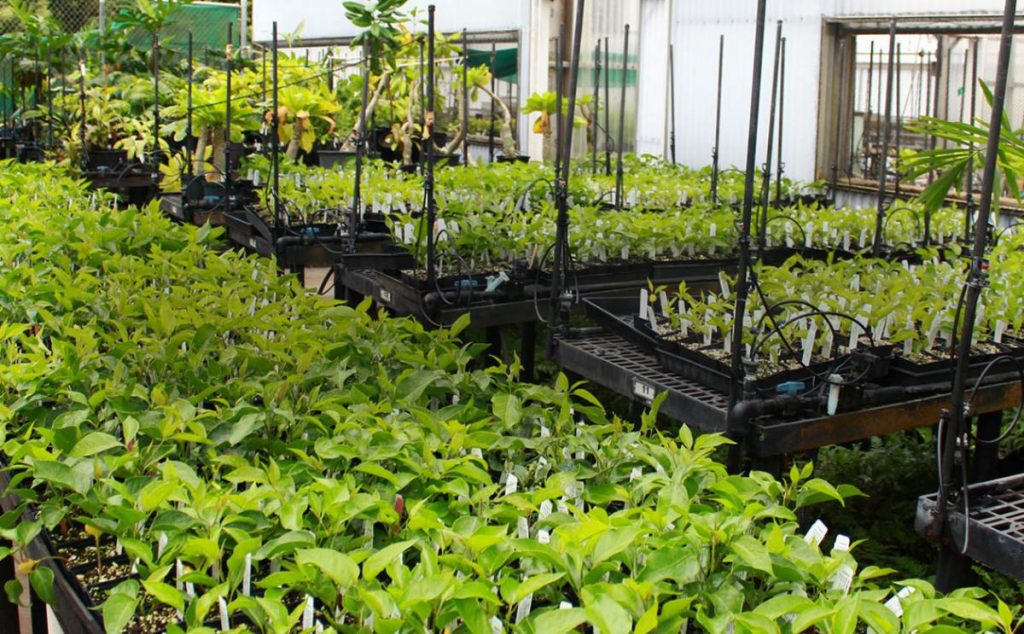
Once harvested seeds were brought back to the NTBG Nursery and Horticulture Center as well as the Seed Bank and Laboratory. Horticulture staff, volunteers, and interns began the monumental task of squeezing out seeds from thousands of fruits to be cleaned, sorted, counted, and potted within hand-built cages to protect from rats. Before long the NTBG nursery was filled with a bright green sea of seeds popping out of a perlite-vermiculite substrate.
“With wild regeneration nearly absent, the burden of survival for this species and its unique sub-populations rests heavily on our Nursery team.”
“With wild regeneration nearly absent, the burden of survival for this species and its unique sub-populations rests heavily on our Nursery team,” states Kevin Houck, NTBG Plant Records Manager. “Dozens of germplasm accessions must be carefully propagated, tracked and nurtured to full vigor prior to outplanting.”
The effort to propagate Polyscias bisattenuata was successful with a survival rate of nearly 80% for the young sprouts. In less than a year, the NTBG nursery grew more than 6,000 plants and transported more than 3,000 to ten reintroduction sites across eastern Kauai. Polyscias bisattenuata seeds were also stored for study at the NTBG Seed Bank and Laboratory and Lyon Arboretum at the University of Hawaii in Honolulu.
“Seed storage behavior of Polyscias bisattenuata remains uncertain but we are conducting germination testing of our seed accessions to ensure they remain viable and ready for future restoration work” says NTBG Seed Bank and Laboratory Manager, Dustin Wolkis.
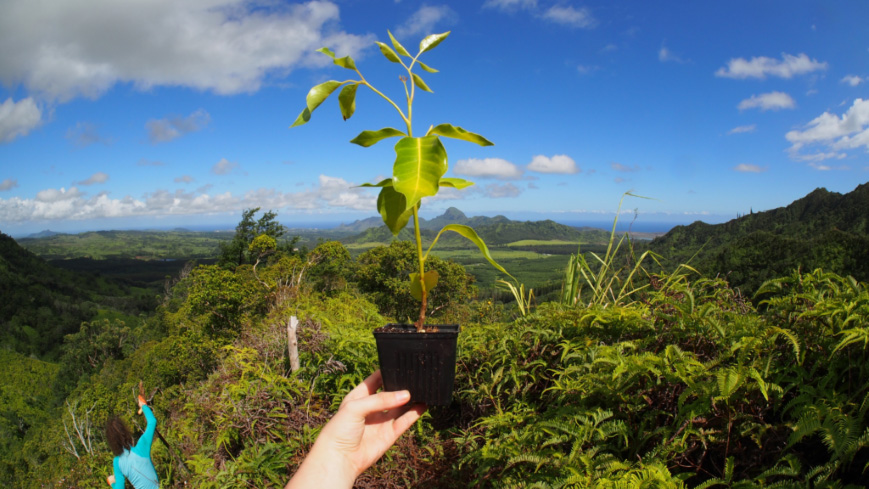
The 2017-2018 outplanting campaign was one of the largest outplanting events of any threatened plant species on Kauai. The chosen reintroduction sites represented a broad range of environmental conditions and microhabitats, and ongoing efforts today aim to discover more about the habitat requirements, reproduction biology, and population dynamics of this rare species.
“After outplanting, we wished the Polyscias bisattenuata luck and left them alone for two years without management,” said Julia. “But, in 2020 I received a grant from the Lyon Arboretum which funded the monitoring of the reintroduced saplings,” she concluded. Julia documented GPS coordinates and monitored the survival of the 2017 outplants. Of the reintroduction sites monitored in January 2020, survival rates ranged from 1% to 34%, which is really good considering this is an extremely rare plant whose habitat preference is unknown.
Inspired by Julia’s initial findings, NTBG applied for a larger science support grant from US Fish and Wildlife Service (USFWS) to continue the work together with a large team of researchers and collaborators from USFWS, US Geological Survey and PEPP – the Plant Extinction Prevention Program.
“In order to better understand what determines outplanting success and improve the conservation plan of this species, we will continue extensive monitoring while also adding sampling to investigate the correlation of success with origin and genetics,” said Nina Rønsted, NTBG Director of Science and Conservation, who leads the project together with Julia and NTBG Living Collections Curator Mike DeMotta.
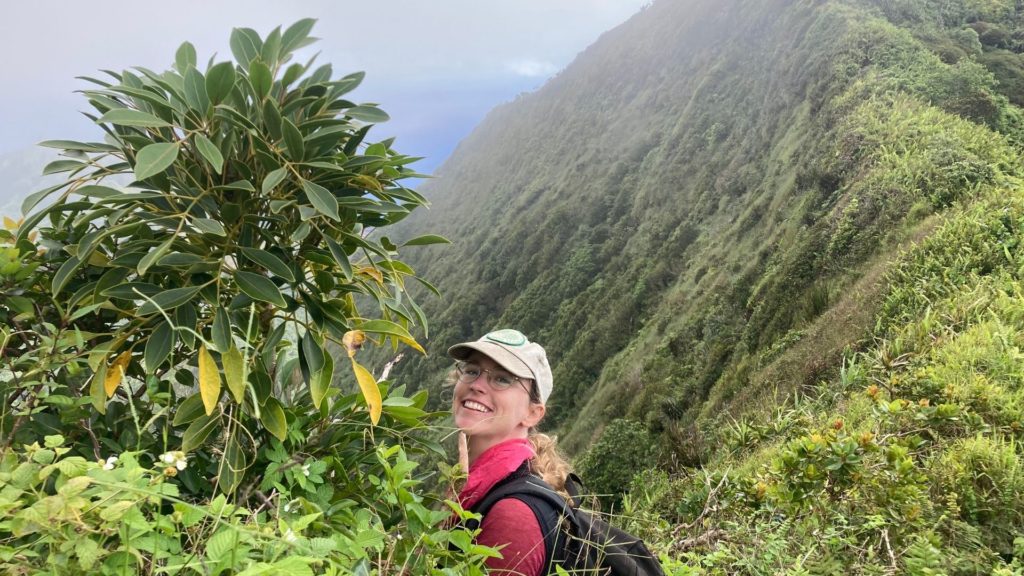
Monitoring of this species continued from November 2021 through January 2022 and approximately 430 plants were recorded alive by Julia, together with a large team of staff, students, and volunteers from both NTBG Living Collections, Science and Conservation, and Limahuli Garden and Preserve remarked Julia. “From the most recent monitoring campaign, we can conclude that most of the loss happened in the first few years. Many saplings are big enough to survive now and we have even observed the first flowering outplants, suggesting natural reproduction is likely to happen, which is really amazing,” exclaimed Julia.
With the success of Polyscias bisattenuata conservation efforts so far, NTBG and collaborators can see hope on the horizon. Additional monitoring and outplanting campaigns are planned, but that doesn’t mean all challenges to the survival of Polyscias bisattenuata have gone. “Rodent predation is still a threat and we need to establish fencing or other protective measures before much more outplanting can be done,” noted Nina.
Until then, it’s hard not to feel hopeful about what the future holds for Polyscias bisattenuata.
“The experience of participating in the planting and monitoring the success of the reintroduction of the ohe mauka has given me hope that with sufficient effort and subsequent rounds of reintroduction and monitoring, this unique component of Kauai’s forest mosaic might be saved from extinction.”
“The experience of participating in the planting and monitoring the success of the reintroduction of the ohe mauka has given me hope that with sufficient effort and subsequent rounds of reintroduction and monitoring, this unique component of Kauai’s forest mosaic might be saved from extinction,” said Julia
Back on that steep montane slope, the tradewinds sound just a little more musical through the clattering leaves of Polyscias bisattenuata trees and carry an unmistakable note of strength and hope.
Hear more about this project directly from our scientists in our webinar: Conservation and Restoration of Endangered Trees.
National Tropical Botanical Garden (NTBG) is a not-for-profit institution, dedicated to discovering, saving, and studying the world’s tropical plants and sharing what is learned.
Our network of five botanical gardens, preserves and research facilities encompasses nearly 2,000 acres with locations in Hawaii and Florida. Thousands of species from throughout the tropical world have been gathered, through field expeditions, collaborations with other institutions and researchers, to form a living collection that is unparalleled anywhere.
Our collection includes the largest assemblages of native Hawaiian plant species and breadfruit cultivars in existence. Many of the species in our collections are threatened and endangered or have disappeared from their native habitats. In our preserves and beyond our gardens, NTBG is working to restore habitats and save plants facing extinction.
Our gardens and preserves are living laboratories and classrooms for staff scientists, researchers, students and visitors from all over the world. You’re invited to be a part of our team. Help us save plants and make a difference by joining as a member! Sign up by May 31, 2022, for a chance to win a VIP experience.